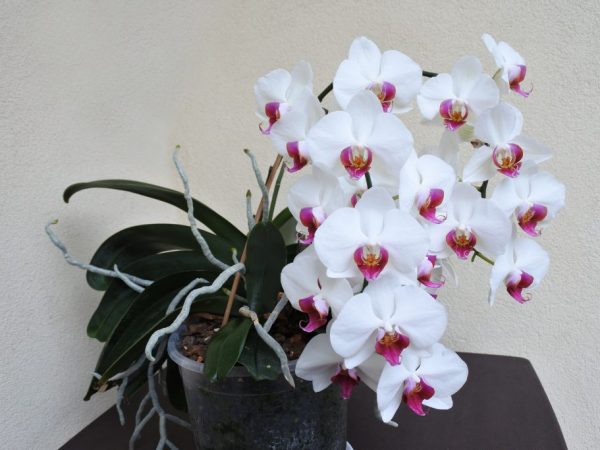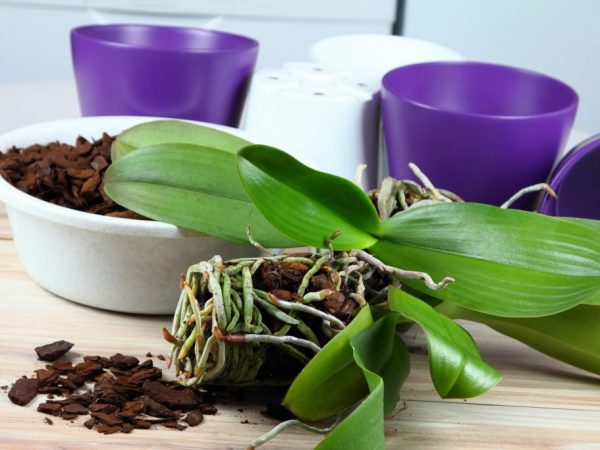Phalaenopsis Cascade orchid variety
One of the most exotic indoor plants is the Phalaenopsis Cascade orchid. With its unusual shape, the cascading orchid attracts attention and brings zest to the interior.

Cascading orchid
Characteristic
The plant has 2 curved peduncles that reach up to 1 m in length. They either intertwine with each other or hang down in an arc to the bottom. The leaves are dark green, wide.
Flowers have different colors: muted pink, bright yellow, white and even maroon.
Phalaenopsis Cascade differs from other species of this plant in the unusual shape of the peduncle, which is formed by florists and some flower growers at home.
How to form a cascading phalaenopsis
Phalaenopsis Cascade Orchid is easy to form at home. As it grows, the peduncle is tied to a support so that the upper half remains free. Over time, the stem tilts itself and takes the shape of an arc. The fully formed arch is tied to a support that exactly repeats the shape of the peduncle. After the buds bloom, the structure is removed.
Growing an orchid cascade
Growing phalaenopsis at home is a painstaking job: the plant is demanding, and care for it must be of high quality.
Phalaenopsis Cascade loves light, it has a special temperature and watering regime.
A substrate is used to help the cascading orchid develop and grow. There is a way to make it at home or buy it in a specialty store. The composition of the substrate includes:
- tree bark,
- crushed cones,
- moss,
- peat.
Such a nutrient medium affects the condition of the houseplant and improves its flowering.
Landing
Phalaenopsis Cascade orchid is planted mainly in transparent plastic pots with good air circulation. Such a capacity makes it possible to control the condition of the substrate and soil, as well as transmit a lot of light, which is important for a cascading orchid. Before planting, the plants are checked for the condition of the root system. If the roots feel sluggish or dry to the touch, begin to rot, they must be removed. After the operation, the root is treated with coal dust. The planting container is also sterilized with boiling water or 2% garden solution.

Planting an orchid cascade
Seed propagation
Growing Phalaenopsis Cascade from seeds is a difficult and long task. At home, they try to save seeds from rot or viral diseases. To grow a healthy plant, the seeds are first disinfected. To do this, they are placed in a 2% hydrogen peroxide solution for several minutes. Also, the glass container for planting is washed, it is preferable to choose a test tube or flask. A prepared nutrient medium is placed in a container, seeds are planted on the surface. After emergence, the sprout is transplanted into a more spacious pot.
Sprout propagation
The cascading orchid grows wonderfully through sprouting. Pruning maintenance is not as painstaking as seed maintenance. A young sprout should not be cut off if its roots are still too small.The sprout is cut off and planted separately, waiting for the roots to grow at least 5 mm. After the baby is cut off, it is placed in a transparent pot, half filled with earth. For the soil, peat with rotted bark is used. The shoot is placed in the middle, evenly distributing the root system over the surface. The substrate is poured on top. After the performed procedure, the pot is placed in the brightest place in the room so that the sprout receives a lot of sunlight.
Plant care
An important condition for phalaenopsis is light, the rays of the sun should be scattered, but under no circumstances direct. Phalaenopsis is rarely watered. There will be no benefit from abundant watering, the plant will begin to rot. High humidity is a direct path to the development of viral diseases, fungi or the appearance of pests. For good growth, the flower is periodically sprayed or moistened with a warm shower. Drafts harm the plant - during the airing of the room, the flower is moved away from the open window.
Diseases and pests
Poor care, contaminated substrate, high humidity lead to the development of diseases or pests. The condition of its leaves, small rashes on the petals and the condition of the substrate helps to determine what is with the flower. If the leaves are rotting, withering, or covered with a rash of a characteristic color, this is a clear sign of disease or the presence of pests. In such cases, chemicals help, which successfully fight sores and pests. Such as the:
- Dr. Foley;
- Brexil Combi;
- Pocon;
- Agricola;
- Fasco.
To treat the flower, collect all the fallen leaves, remove the infected areas on the plant, sprinkle with coal dust. The flower is treated with one of the life-saving means, the substrate is changed.
Prophylaxis
In order to prevent infection, first of all, carefully choose a flower, soil and substrate without signs of disease.
Proper care and timely watering are the best preventive methods for a houseplant. Also, for prevention, chemical preparations are occasionally used while spraying a flower. The biological product Fitoverm is suitable for this.
Conclusion
Phalaenopsis Cascade Orchid is a demanding plant that can decorate any home with an abundance of colors, exotic shape and wonderful aroma.


